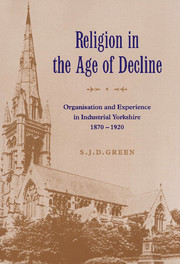Book contents
- Frontmatter
- Contents
- Acknowledgements
- List of tables
- List of abbreviations
- Introduction
- Part I Providing the means
- Part II Drawing in the people
- 4 The unfolding of the associational ideal: auxiliary organisations and ambitious societies
- 5 Learning advanced: the Sunday school movement, pedagogical innovation and the theory of juvenile religious development
- 6 Salvation extended: conversion, revivals and the unending mission to the people
- Part III The trials of the religious life
- Conclusion
- Bibliography
- Index
5 - Learning advanced: the Sunday school movement, pedagogical innovation and the theory of juvenile religious development
from Part II - Drawing in the people
Published online by Cambridge University Press: 08 October 2009
- Frontmatter
- Contents
- Acknowledgements
- List of tables
- List of abbreviations
- Introduction
- Part I Providing the means
- Part II Drawing in the people
- 4 The unfolding of the associational ideal: auxiliary organisations and ambitious societies
- 5 Learning advanced: the Sunday school movement, pedagogical innovation and the theory of juvenile religious development
- 6 Salvation extended: conversion, revivals and the unending mission to the people
- Part III The trials of the religious life
- Conclusion
- Bibliography
- Index
Summary
Introduction: Sunday schools and the mission to the people
To provide the means of worship – materials and money – demanded difficult choices and exacted uneasy compromises in the religious organisations of later Victorian and Edwardian West Yorkshire. But to bear witness to the truth, to teach the word and to inspire others to the faith, was generally understood to be, if not easy, then at least straightforward: at once a spiritual duty and a social obligation. Yet this was rarely the case. Certainly, the worldly frustrations of sacred societies as teacher and proselytiser were no less important than those they endured as trustee and pastor. Committed to teaching the word, they saw only too well how often it was repudiated. Bound to preach the right, they knew how frequently it was traduced; and if not rudely ignored, then acknowledged only with that polite tolerance which foreshadowed subsequent indifference.
Nowhere did that indifference seem more striking to intelligent churchmen and ministers than in the mid-Victorian Sunday school. Here lay a paradox. At one level, no religious institution reached more people in the nineteenth-century town; very few of those born, bred and living in these West Riding towns during the years of their industrial and demographic expansion can have passed through life without some exposure to the ways and word of Christian witness.
- Type
- Chapter
- Information
- Religion in the Age of DeclineOrganisation and Experience in Industrial Yorkshire, 1870–1920, pp. 211 - 255Publisher: Cambridge University PressPrint publication year: 1996



